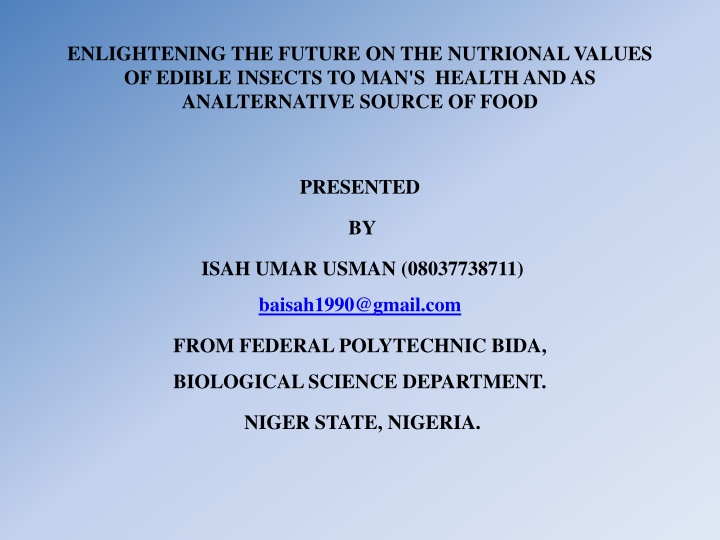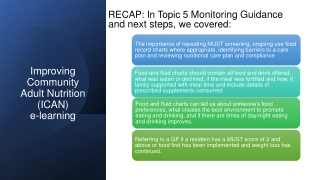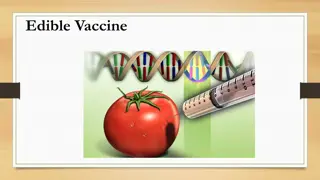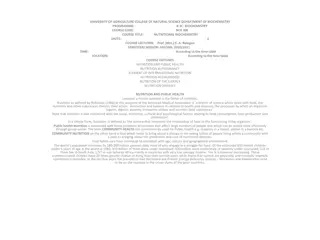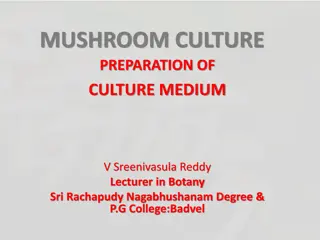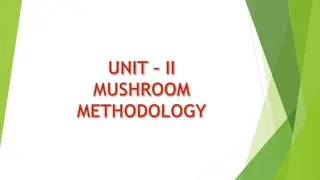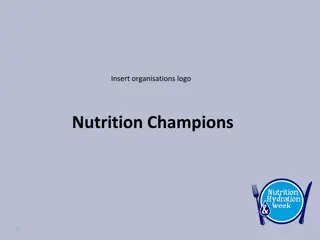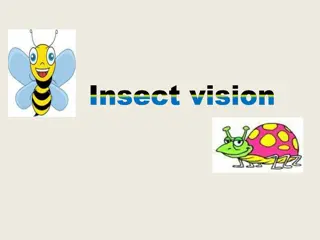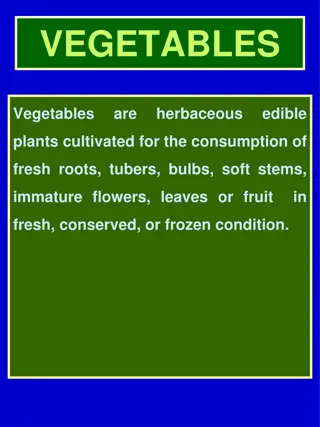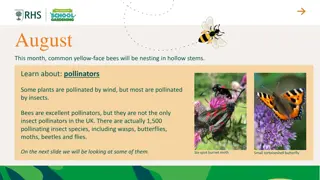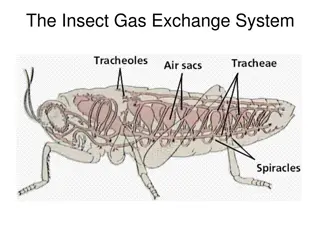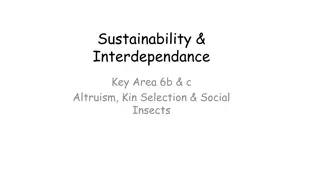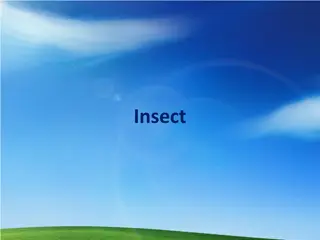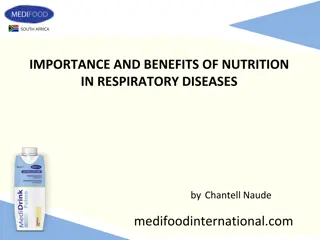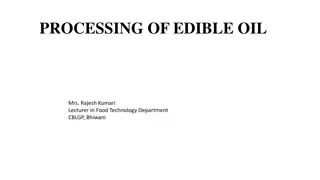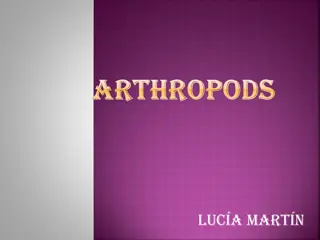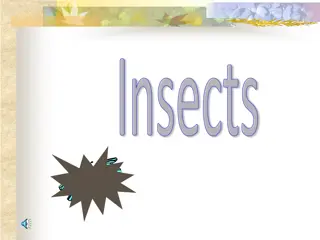Enlightening Future on Nutritional Values of Edible Insects for Health
Edible insects are a valuable protein source with potential health benefits and economic advantages. This research explores the nutritional value of edible insects, their role as an alternative food source, and their impact on human health. Findings highlight the importance of promoting the consumption of edible insects as a sustainable nutrition source.
Download Presentation

Please find below an Image/Link to download the presentation.
The content on the website is provided AS IS for your information and personal use only. It may not be sold, licensed, or shared on other websites without obtaining consent from the author.If you encounter any issues during the download, it is possible that the publisher has removed the file from their server.
You are allowed to download the files provided on this website for personal or commercial use, subject to the condition that they are used lawfully. All files are the property of their respective owners.
The content on the website is provided AS IS for your information and personal use only. It may not be sold, licensed, or shared on other websites without obtaining consent from the author.
E N D
Presentation Transcript
ENLIGHTENING THE FUTURE ON THE NUTRIONAL VALUES OF EDIBLE INSECTS TO MAN'S HEALTH AND AS ANALTERNATIVE SOURCE OF FOOD PRESENTED BY ISAH UMAR USMAN (08037738711) baisah1990@gmail.com FROM FEDERAL POLYTECHNIC BIDA, BIOLOGICAL SCIENCE DEPARTMENT. NIGER STATE, NIGERIA.
TABLE OF CONTENTS: . ABSTRACT . INTRODUCTION OBJECTIVES RESEARCH QUESTIONS FINDINGS/DISCUSSIONS CONCLUSION FURTHER RESEARCH
ABSTRACT: Edible insects are important natural protein resource that can contribute to resilient food security. Edible insects not only play an important role in traditional diets, but are also an excellent source of protein in traditional dishes in the world nowadays. Therefore the principal aim of this paper is to portray and enlighten the future on the nutrional values of edible insects to man's health and as an alternative source of food considering the low economic situation that the world has found itself. Edible insects could be use due to their high excellent nutrional content, potential socio-economic benefits. The method adopted for this research is using content analysis. During which different search strategies were used to access published articles to review literatures of some other authors in the field of applied entomology inorder to trace significant value of edible insects as an alternative source of food to man and their values to his health as well. The search terms includes but not only limited to the following: what are edible insects, Are the edible insects valuable to man at all, do the edible insects contribute to bio economic growth etc. Lastly References in the identified articles were used, reviewed to draw conclusion that the edible insects have nutrional values to man's health and also can serve as an additional alternative source of food to him and could be use for an economic growth as well. The results of this study confirm the fact that insects are indeed a good source of protein and other nutrients. Therefore consumption of non-toxic insects, should be encouraged, as they serve as an alternative nutrition source in human diets like protein supplements, have much nutrients to offer and economic growth as well. Key points: Edible insects, Economy, Food, Health,Nutrition.
INTRODUCTION: Insects are a class of animals within the arthropod phylum. The total number of insect species on Earth is estimated to be 2-3 million and the class probably represents more than 90% of all animal Species. Insects can be found in nearly all environments, although only a few species occur in the oceans. Spiders and scorpions, which can also be eaten by humans, are not insects but belong to the arthropods. Insects share the nutritional benefits of animal-source foods and can provide valuable nutrients as a part of a varied diet. Edible insect species may be a source of novel bioactive compounds addressing the enormous global health challenges in low- as well as high-income countries.
What is an Entomophagy? The practice of consuming insects is called entomophagy, from the Greek ntomon, insect, and phagein, to eat. What are edible insects? Are all the insect types which are considered edible for human consumption consisting of about 2000 species. Examples of commonly consume edible insects: The insects most commonly consumed worldwide are beetles consisting of order (Coleoptera, 31% of all insect species consumed), caterpillars (Lepidoptera, 18%) and bees, wasps and ants (Hymenoptera, 14%). Moreover, grasshoppers, crickets and locusts (Orthoptera, 13%) and cicadas, leafhoppers, planthoppers, scale insects and true bugs (Hemiptera, 10%) are consumed. Termites (Isoptera), dragonflies (Odonata), flies (Diptera) and other insects each comprise less than 3% of insects consumed.
OBJECTIVES: The principal aim of this research is to portray and enlighten the future on the nutrional values of edible insects to man's health and as an alternative source of food considering the low economic situation that the world has found itself.
RESEARCH QUESTIONS: The following important search questions could be ask in the course of this research: 1)What are edible insects? 2) What is an entomophagy? 3) What are the nutritional composition of insects that enable them to be use as human food supplements? 4) Are the insects important to human health?
FINDINGS/DISCUSSIONS: Nutrient Composition of An Edible Insects that make them Valuable To Man: The nutrient content of insects varies considerably between species and also between the different development phases. The amino acid profile differs between insect species, but it appears that many species may contribute well to an optimal diet for humans, even in very small children. Nevertheless, researchers generally agree that insects are extremely rich in protein, fat, and vitamins, as summarize as follow: On average, the protein content of edible insects ranges 35% 60% dry weight or 10% 25% fresh weight, which are higher than plant protein sources, including cereal, soybeans, and lentils. At the upper range, insects provide more protein than even meat and chicken eggs. Edible insects in Orthoptera (crickets, grasshoppers, locusts) are particularly protein-rich. However, insect protein digestibility is highly variable due to the presence of a hard exoskeleton. Orthoptera, Lepidoptera (caterpillars), cockroaches (blattodea), Isoptera (termites), Hemiptera, and Coleoptera (beetles, grubs) have the averaged fat content of 13.41%, 27.66%, 29.90%, 32.74%, 30.26%, and 33.40%, respectively. Larvae and pupae have more fat than adult insect. In addition, females are fatty than males. The averaged carbohydrate content of edible insects ranges from 6.71% (stink bug) to 15.98% (cicada). Some insects (e.g., grasshoppers, crickets, termites, and mealworms) are rich in iron, zinc, calcium, copper, phosphorus, magnesium, and manganese. It has been found that consuming insects can provide the high proportions of daily mineral recommendations for humans, particularly in terms of iron. It has also been found that edible insects contain carotene, vitamin B1, B2, B6, C, D, E, and K.
MEDICINAL APPLICATIONS OF EDIBLE INSECTS TO MANS HEALTH: 1)Antioxidants: Several studies have reported antioxidant activity in insect species. Antioxidants, in principle, have the potential to prevent molecular damage in the human body, and foods rich in antioxidants have been considered potentially beneficial in the prevention of cardiovascular and other diseases. 2)Hypertension: High blood pressure is one of the leading preventablerisk factors for premature death and disability worldwide, affecting up to one third of the world s population. Angiotensin is a peptide hormone that causesvasoconstriction and a subsequent increase in bloodpressure. An enzyme converts the hormone angiotensinI to the active vasoconstrictor angiotensin II. As a result,the angiotensin-converting enzyme (ACE) causes blood vessels to constrict, which is why ACE inhibitors are used as pharmaceutical drugs for the treatment of cardiovascular diseases. ACE inhibitory activity is widely distributed in mammalian tissues, and has also been identified in a number of insects. Species such as wax moth Galleria mellonella, the yellow mealworm Tenebrio molitor and the silkworm Bombyx mori have been found to have levels of ACE inhibitory activity comparable with other food sources.
3)Obesity and type 2 diabetes Studies in mice models have indicated bioactive compounds in insects, which may be effective in weight control. Study showed that the daily intake of yellow mealworm larvae powder by obese mice attenuated body weight gain by reducing lipid accumulation and triglyceride content in adipocytes, thus indicating the potential of a bioactive compound to induce weight loss. Another pathway of bioactivity investigated entails a reduction in endoplasmic reticulum (ER) stress. ER is a cellular condition found in obese as well as type 2 diabetes patients causing a function failure of cells, including insulin-producing beta cells. 4)Chitin and immunity: Chitin, a primary component of the exoskeletons of arthropods, represents the second-most abundant polysaccharide in nature, after cellulose. Humans do not synthetise chitin. Therefore, chitin-containing protozoa, fungi, arthropods, and nematodes are targeted for recognition by the immune system. Chitin and its degradation products are sensed primarily in the lungs or gut, where it activates a variety of innate and adaptive immune cells. Chitin induces cytokine production, recruits leukocytes, and activates macrophages. Chitin can be degraded by chitinases identified in the human digestive fluid. The function of chitinases is not only to catalyse the hydrolysis of chitin- producing pathogens, but seems to include a crucial role in bacterial infections and inflammatory diseases.
5)Vitamin B12 Cobalamin or vitamin B12 is synthesised by certain bacteria and algae and accumulates in meat, milk and other animal-source food, as the only natural food source of vitamin B12 for humans. Vitamin B12 plays a key role in the functioning of the brain and nervous system and in the formation of red blood cells. Few insects have been analysed for vitamin B12. Among them house cricket Acheta domesticus, yellow mealworm T. molitor, wax moth G. mellonella, and silkworm B. mori. 6)Parkinson s disease and silkworm Parkinson s disease affects 6 million people each year, resulting in more than 100,000 deaths each year. Study found that when boiled and freeze-dried powderof the silk worm B. mori was fed to Drosophila flies, lifespanincreased, while symptoms of rotenone- induced Parkinson sdisease were reduced. 7)Medicine The traditional claims of medicinal properties have resulted in multiple studies aiming to empirically determine the properties of edible insects. Cultures that consume insects also tend to associate them with various health benefits beyond nutrition. For example, caterpillar fungus supposedly has immunostimulatory and anti-cancer properties. Some evidence exists to suggest that termites (Macrotermesannandalei) may have immunostimulatory effects. Another insect historically considered to have beneficial health effects is the silkworm (Bombyx mori L.). Recent analyses have identified a blood glucose- lowering agent, resulting in the development of silkworm powder as a diabetic medicine in Korea.
RECOMMENDATIO AND CONCLUSION: RECOMMENDATION: With the above findings, consumption of non-toxic edible insects by man is encourage as they play an important role in human nutrition and have much nutrients to offer. CONCLUSION: The results of this study confirm the fact that insects are indeed a good source of protein and other nutrients. Therefore consumption of edible, non-toxic insects, should be encouraged, as they serve as an alternative nutrition source in human diets like protein supplements, and can also be use boost economic growth as well.
FURTHER RESEARCH: With this research findings further research is highly recommended more especially on the chemical composition of edible insects which is not covered in this study.
